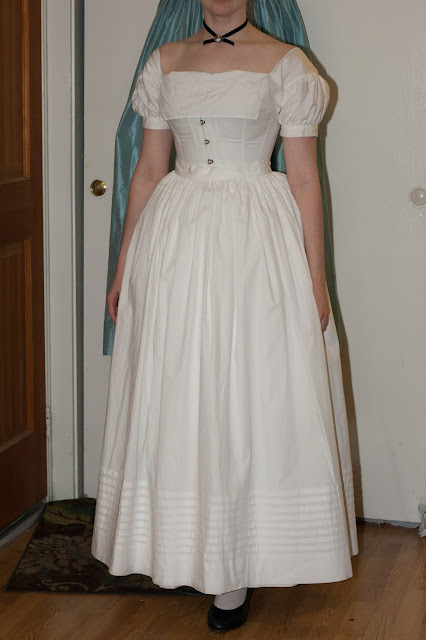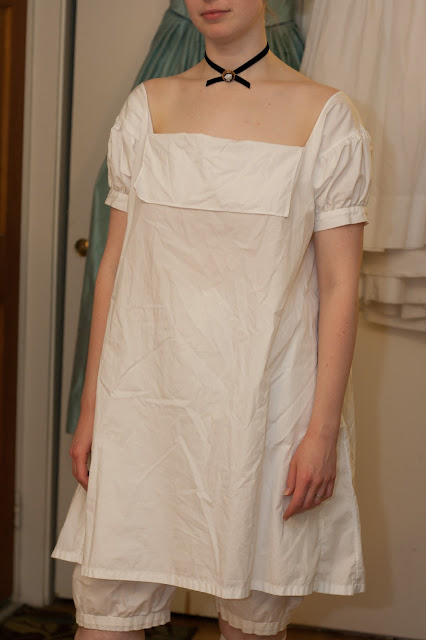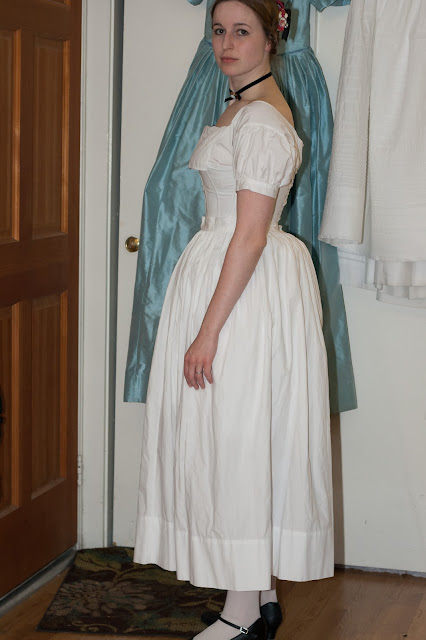After much study and deliberation, I have formulated a game plan. My vision for the dress is a bodice based loosely on this dress:
1898-1900 Jacques Doucet, Met Museum
I love the draped crossover bodice with chiffon peeking out at the neckline, and I'm really into the idea of shoulder drapery, though I will probably use more chiffon instead of flowers.
I want my skirt to have a little more visual interest, so I'm thinking about a flounce and embellishment inspired by this dress:
1898-1900 House of Worth, Met Museum
Though I'm sure I won't have the patience to cover my flounce in spangles, I very much like the line of applique/embroidery where the flounce attaches to the skirt.
To plan the actual construction of the dress, I have been consulting all my usual reference books and resources. In addition, I have found Cathy Hay's Worth Oak Leaf dress diary especially insightful. She faithfully recreated an incredible 1903 evening gown by the famous design house, right down to the insanely detailed embroidery. Here's the original dress:
1903 House of Worth
And yes, her version is about as jaw-droppingly beautiful as the original. While I have absolutely no intention of putting even a tiny fraction of the effort she did into the embellishment of my gown, I found her notes, photographs, and diagrams of the dress immensely helpful. Please go visit her site and enjoy it as much as I have.
In addition to her dress diary, I have studied period patterns and dressmaking manuals, patterns taken from extant dresses, and photographs of dresses in museum collections. Based on these sources, I have identified a few nearly universal techniques for the construction of evening/ball gowns from this period:
1. The bodice, rather than being flat-lined, is built over a separate silk lining, sometimes an off-white color, sometimes a shade to compliment the outer fabric. This bodice base is boned and has a petersham waist stay, and has its own closure in either the front or the back.
An example:

1897 House of Worth, Met Museum
This photo is intended to show the stay tape and label, but it also shows inside of the bodice base. Notice all the vertical seams and the hand-finishing. Seam allowances are overcast, bone casings and stay are hand-stitched in place, and the bottom edge is finished with a facing or tape. You can see the outside fabric (actually a piece of ribbon in this case) peeking out from the bottom. It is clearly separate from the lining.
2. The outer layers of the bodice are arranged and applied to this base. They have their own closure, either concealed in their drapery, or along one of the side seams. The careful placement of closures completely disguises the openings.
The same bodice as above, but from the outside this time:
1897 House of Worth, Met Museum
It is clear that all the frill and frouf that constitutes the outside of the bodice is lightly applied to the exterior, and is not in any way structural. The boned lining provides all the structure, the rest is just decoration. This is true even of more solid-looking bodices, like the silver-blue Worth dress above.
Here is its bodice laid flat:
1898-1900 Worth, Met Museum
If you look closely at the inside back edge, you'll see the outer fabric floating free from the lining, which has a drawstring at its upper edge (also a common feature). That back piece wraps across the back from the right hand side of the body to the left, where it fastens with hooks and eyes along the side seam (just visible in the full-length photo up above).
3. The skirt is usually separate from the bodice and has a free-hanging lining. This lining serves as a petticoat, with rows of ruffles to help fill out and support the bottom of the skirt. The skirts close at the center back.
You can see the free-hanging skirt lining in this dress:
1899 House of Worth, Met Museum
Within the framework of these general guidelines, there is a huge amount of variation in the patterning, cut, layering, and ornamentation. The bodice linings are fairly standard, following the common bodice shapes of the 1890s, but the skirts can be cut in any number of ways. Most are gored, but the size, shape, and number of gores vary widely. Some skirts are cut with only a single front gore, paired with large circular-cut panels extending to the back. A very few skirts are cut in a single-piece, circle skirt layout, though the narrow width of period silks makes this an uncommon technique. The gored skirts tend to have some pleating or gathering where the back portions attach to the waistband, while the circular skirts tend to be fitted much more smoothly over the hips.
I prefer this smooth-fitted approach, and also like the easiness of a circular skirt — fewer seams — so I plan to cut my skirt as one large circular shape. If you take a look at the diagram of the Worth dress by Cathy Hay, you will see the shape that I am using for my skirt. This is supported by a dress in Janet Arnold, as well as a few period patterns in The Voice of Fashion.
I have decided to make my dress without a train, even though they were very popular in this period. Every extant dress I have seen has a long sweeping train, but I personally have no desire to experiment with dancing in one. I have seen written references to "dancing length" dresses, showing that at least some women thought about foregoing the fashionable trend in favor of practicality. But without having seen even one example of such a dress, I am doubtful as to the historical accuracy of my choice. Since I am wearing this to a ball where I will be dancing for hours, I have decided that I am willing to compromise historical accuracy in order to be able to dance without fear of me or anyone else stepping on my elegant train and tearing it to pieces. These are the choices we costumers must sometimes make.
Here's a lovely painting showing ladies dancing in dresses that do not appear to have long trains:
The Ball, Victor Gabriel Gilbert
For my bodice base, I am using the basic 1890s bodice pattern from Period Costume for Stage and Screen (pg 146-7). I considered using the Truly Victorian 1892 Ball Gown Bodice, which would have given a similar shape (raising the bottom edge, and dropping the giant sleeves of course), but decided to save my money and just work with the pattern from the book. I was very lucky, the pattern required very little alteration once I scaled it up.
For embellishment, I bought a beaded trim in grey and silver that I thought was somewhat evocative of the cloud motifs on the blue Worth dress above. I also plan to accent the dress with black velvet.
Here's a picture of all my materials together:
From left to right: pink acetate taffeta for my lining, blue-green silk taffeta for the body of the dress (shown with the grey and silver beaded trim for embellishing the skirt), peachy pink silk taffeta for an accent color, pale pink chiffon for the neckline/shoulders and the skirt flounce (shown with black velvet ribbon, which will get worked in somewhere)

From left to right: pink acetate taffeta for my lining, blue-green silk taffeta for the body of the dress (shown with the grey and silver beaded trim for embellishing the skirt), peachy pink silk taffeta for an accent color, pale pink chiffon for the neckline/shoulders and the skirt flounce (shown with black velvet ribbon, which will get worked in somewhere)
I have already made mockups of my bodice base (from Jean Hunnisett) and my skirt pattern (from the Oak Leaf dress and a dress in Patterns of Fashion by Janet Arnold, pg 50-51). I cut out the bodice lining, the skirt lining, and outer skirt over the weekend, and will hopefully start sewing my dress this week!
I'll post an update once I have something worth seeing.




































